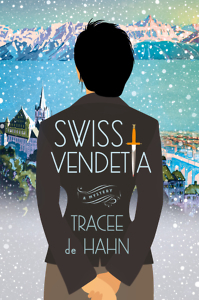Murder in a Cold Climate
Death and history merge in Tracee de Hahn’s debut
 On the afternoon before what turns out to be the worst blizzard in centuries, a young woman, dressed in a coat over an evening gown, flees from a Swiss chateau. Later she is found dead—not from exposure but from a knife wound. In Lausanne, Agnes Lϋthi is assigned the case, her first since transferring to Violent Crimes from Financial Crimes after the death of her husband. She makes it to the chateau just as ice completely blocks the roads, knocks out electricity, and shuts off communication with the outside world. In Swiss Vendetta, Tracee de Hahn has written a tale of murder, secrets, and history, both personal and global.
On the afternoon before what turns out to be the worst blizzard in centuries, a young woman, dressed in a coat over an evening gown, flees from a Swiss chateau. Later she is found dead—not from exposure but from a knife wound. In Lausanne, Agnes Lϋthi is assigned the case, her first since transferring to Violent Crimes from Financial Crimes after the death of her husband. She makes it to the chateau just as ice completely blocks the roads, knocks out electricity, and shuts off communication with the outside world. In Swiss Vendetta, Tracee de Hahn has written a tale of murder, secrets, and history, both personal and global.
The victim was an art appraiser from London at the chateau to take inventory. No one knows why she was wearing an evening gown. In fact, no one at the chateau seem to know much about her at all—or they’re not telling. The family and their servants are reticent, but the timing of the storm means that someone at the chateau or the neighboring mansion must be the killer.
Agnes’s assistants include a local police officer, a colleague from Financial Crimes (the only other officer could make the trip in the storm), a local doctor, and the Good Samaritan who helped guide these last two to the chateau from the village. Not an auspicious team for a murder investigation.
Agnes is an intriguing protagonist. She is still trying to make sense of her husband’s death, and his memory plays on her emotions at inopportune times. She is also an outsider—born to American parents, she has never been fully accepted in Swiss culture. She is an outsider at the chateau, as well, a commoner in the midst of centuries of privileged aristocracy:
“What is it you do exactly?” she asked to cover her discomfiture.
“I’m a collector.”
“Art? Antiques?”
“Buildings. Houses mainly. They’re an art form of sorts.”
She sighed. Most people she knew collected hotel soaps or postcards.
 History pervades Swiss Vendetta. An American history student is using the chateau’s library to conduct research, and the chateau itself is so old that not even its inhabitants know how many hidden stairways and rooms exist. At the mansion next door, an ancient World War II survivor who has witnessed unspeakable evil encourages Agnes: “You have not seen murder before. Do not argue. This is a truth. You were nervous when you arrived tonight, the thought of crossing near where the woman died was disturbing. Ghosts were in your mind. But you have courage. You made the journey alone. I know this because I remember the first time I saw murder. I was not seventeen. And this is how I know that evil can come out of the ordinary.”
History pervades Swiss Vendetta. An American history student is using the chateau’s library to conduct research, and the chateau itself is so old that not even its inhabitants know how many hidden stairways and rooms exist. At the mansion next door, an ancient World War II survivor who has witnessed unspeakable evil encourages Agnes: “You have not seen murder before. Do not argue. This is a truth. You were nervous when you arrived tonight, the thought of crossing near where the woman died was disturbing. Ghosts were in your mind. But you have courage. You made the journey alone. I know this because I remember the first time I saw murder. I was not seventeen. And this is how I know that evil can come out of the ordinary.”
Tying all these elements together, de Hahn creates a spellbinding story with fully-developed characters that are both suspicious and sympathetic. Readers, like Agnes herself, will find themselves hoping that none of them is the killer—and that a blizzard will hit their own roads, so nothing interrupts their time in Agnes’s company.

Faye Jones, dean of learning resources at Nashville State Community College, writes the Jolly Librarian blog for the college’s Mayfield Library. She earned her doctorate in nineteenth-century literature at Indiana University of Pennsylvania.


